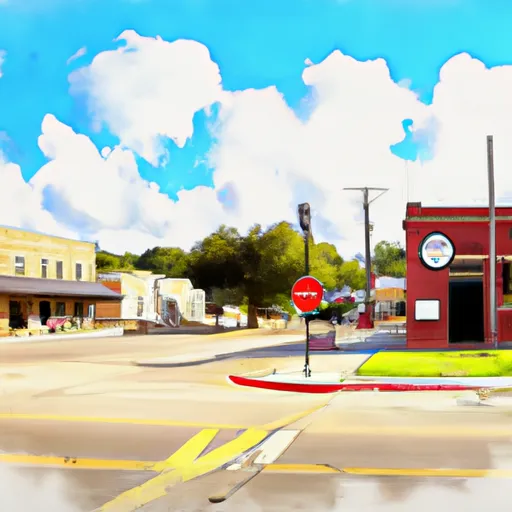-
 Snoflo Premium
Snoflo Premium
Get unlimited access to all our content
With no Ad interruptions! - Start Your Free Trial Login with existing account
Maypearl
Eden Index
Climate
9.7
•
Recreation
2.2
•
Community
2.6
•
Safeguard
5.3/10

Maypearl is a small city located in Ellis County, Texas. Known for its rural charm and close-knit community, Maypearl experiences a humid subtropical climate. Summers are typically hot and humid, with average temperatures ranging from the mid-70s to the mid-90s Fahrenheit. Winters are generally mild, with average temperatures ranging from the mid-30s to the mid-50s Fahrenheit.
Maypearl is situated near several bodies of water, including the Chambers Creek, which is a tributary of the Trinity River. This hydrological feature contributes to the city's scenic beauty and also provides opportunities for outdoor activities such as fishing and boating.
Outdoor recreation enthusiasts in Maypearl can also explore the nearby Lake Waxahachie, offering additional opportunities for fishing, boating, and water sports. The area surrounding the city provides ample space for hiking, camping, and picnicking, making it an ideal destination for nature lovers.
In conclusion, Maypearl, Texas, offers a pleasant climate, with hot summers and mild winters. Its hydrological features, such as Chambers Creek and Lake Waxahachie, provide opportunities for fishing, boating, and other water-based activities. Moreover, the surrounding areas offer various outdoor recreation opportunities, making Maypearl an appealing destination for nature enthusiasts.
What is the Eden Index?
The Snoflo Eden Index serves as a comprehensive rating system for regions, evaluating their desirability through a holistic assessment of climate health, outdoor recreation opportunities, and natural disaster risk, acknowledging the profound impact of these factors on livability and well-being.
Climate Health Indicator (CHI): 9.7
Maypearl receives approximately
949mm of rain per year,
with humidity levels near 78%
and air temperatures averaging around
19°C.
Maypearl has a plant hardyness factor of
8, meaning
plants and agriculture in this region tend to thrive here all year round.
By considering the ideal temperature range, reliable water supplies, clean air, and stable seasonal rain or snowpacks, the Climate Health Indicator (CHI) underscores the significance of a healthy climate as the foundation for quality living.
A healthy climate is paramount for ensuring a high quality of life and livability in a region, fostering both physical well-being and environmental harmony. This can be characterized by ideal temperatures, reliable access to water supplies, clean air, and consistent seasonal rain or snowpacks.
Weather Forecast
Streamflow Conditions
Upper Trinity
Area Rivers
Upper Trinity
Snowpack Depths
Upper Trinity
Reservoir Storage Capacity
Upper Trinity
Groundwater Levels
Recreational Opportunity Index (ROI): 2.2
The Recreational Opportunity Index (ROI) recognizes the value of outdoor recreational options, such as parks, hiking trails, camping sites, and fishing spots, while acknowledging that climate plays a pivotal role in ensuring the comfort and consistency of these experiences.
Access to outdoor recreational opportunities, encompassing activities such as parks, hiking, camping, and fishing, is crucial for overall well-being, and the climate plays a pivotal role in enabling and enhancing these experiences, ensuring that individuals can engage in nature-based activities comfortably and consistently.
Camping Areas
| Campground | Campsites | Reservations | Toilets | Showers | Elevation |
|---|---|---|---|---|---|
| Brier Creek - Lake Texoma | None | 656 ft | |||
| Juniper Point - Lake Texoma | None | 655 ft | |||
| Isle du Bois - Roberts Lake State Park | 182 | 685 ft | |||
| Falls on the Brazos Park | 15 | 335 ft | |||
| Texoma Marina | None | 651 ft | |||
| Johnson Branch - Roberts Lake State Park | 163 | 685 ft | |||
| Cedar Bayou Marina - Lake Texoma | None | 647 ft | |||
| Walnut Creek Resort | 25 | 650 ft | |||
| Little Elm Park | None | 547 ft | |||
| Sheppard AFB Military - Lake Texoma | None | 657 ft |
Nearby Ski Areas
Catastrophe Safeguard Index (CSI):
The Catastrophe Safeguard Index (CSI) recognizes that natural disaster risk, encompassing floods, fires, hurricanes, and tornadoes, can drastically affect safety and the overall appeal of an area.
The level of natural disaster risk in a region significantly affects safety and the overall livability, with climate change amplifying these risks by potentially increasing the frequency and intensity of events like floods, fires, hurricanes, and tornadoes, thereby posing substantial challenges to community resilience and well-being.
Community Resilience Indicator (CRI): 2.6
The Community Resilience Indicator (CRI) recognizes that education, healthcare, and socioeconomics are crucial to the well-being of a region. The CRI acknowledges the profound impact of these elements on residents' overall quality of life. By evaluating educational resources, healthcare accessibility, and economic inclusivity, the index captures the essential aspects that contribute to a thriving community, fostering resident satisfaction, equity, and social cohesion.

